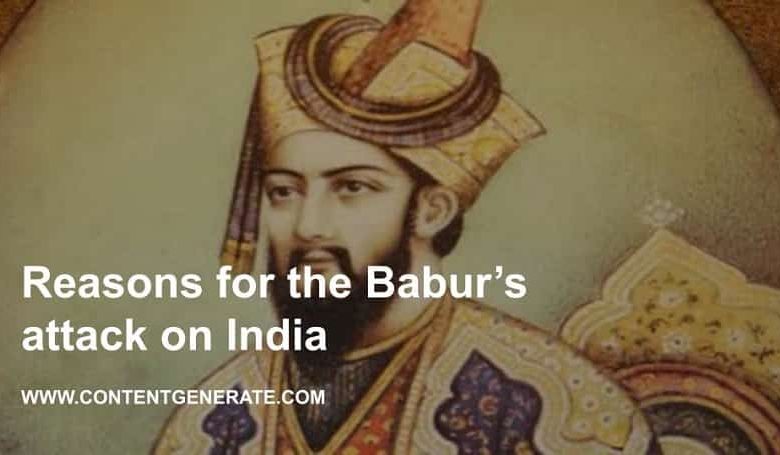Reasons for Babur’s Attack on India

This post discusses the reasons behind Zahiruddin Babur’s attack on India in 1525. The article also gives an introduction of Babur and the details of the events that took place in the aftermath of the invasion such as the First Battle of Panipat, the death of Sultan Ibrahim, and the establishment of the Mughal Empire.
Contents
Who was Zaheer-ud-din Babur?
Zaheer-ud-din Babur was a Central Asian war chieftain and a descendant of the Mongol conqueror Genghis Khan and Tamerlane. Earlier, Babur reigned the principality of Fergana which he lost while he was unsuccessfully trying to reinforce his hold on Samarkand, a place his father ruled earlier.
Forced to flee his ancestral territories, Babur occupied Kabul with his personal followers from where led invasions into central Asia and later on India. After consistent failures to recover Samarkand, Babur turned his eyes on India. He led an invasion into India in 1525, defeated the forces of Sultan Ibrahim in 1526, and laid the foundation of the Mughal Empire in India.
According to historians the reasons that led to Babur’s Indian campaign in 1525 included his failure in the Central Asian quest to regain Samarkand, Invitation from Indian governors, and support of Safavids and the Ottoman empire in the establishment of a new Muslim empire in the Indian subcontinent.
Reasons for Babur’s invasions into India
According to historians, there were two important reasons for Babur’s invasion of India.
1. Babur’s failure to recover Samarkand;
2. Invitation from disgruntled family members of the Sultan.
The following is an elaboration of the above-mentioned reasons:
1. Babur’s Failures in Central Asia
The ancestors of Babur once ruled Samarkand which was lost by his father other Timurid descendants. His father made several attempts to regain control of Samarkand but in vain.
Babur also attempted to recover Samarkand from 1497 to1501. He was successful in occupying Samarkand briefly to lose it again. In his attempt to control Samarkand, he also lost the principality of Fergana which he ruled. Defeated in Central Asia, Babur occupied Kabul and made it the center of his future invasions. His last attempt on Samarkand was between 1511 and 1512 in which he was pushed back even more strongly.
With continuously failed attempts to retake Samarkand and Fergana, Babur had this realization that further campaigns would also be nothing less than a futile exercise. With this realization, Babur turned his eyes to the east into the Indian subcontinent and started preparing to lead invasions with the aim to establish an Indian empire.
2. Invitation from India
One of the reasons behind the Babur’s motivation to attack India was the Invitation from the disgruntled governors of Sultan of Delhi. For instance, Dilawar Khan and Alam Khan, two important family members of Sultan Ibrahim, went to Kabul to seek Babur’s help to replace the Sultan.
The offer of support in ousting the sultan encouraged Babur to agree to the proposal. For Babur, it was an omen for a powerful empire that he was going to establish in India. Thus, the Mongol war chieftain set out in November 1525 from Kabul on his fateful campaign to bring India under his rule.
India at the time of Babur’s attack
There were two dynasties in power — the Sultanate of Delhi under Ibrahim Lodi, and Rajputana ruled by a Hindu Rajput Confederacy, led by Rana Sanga of Mewar. However, the empire under Lodhi was crumbling under a weak leadership and rebellion. Daulat Khan Lodi, Governor of Punjab and Ala-ud-Din, Lodi’s uncle, invited Babur to wage a war and take over.
Babur’s invasion and battles
1. Encounter at Lahore
On way to Delhi, Babur had his first encounter with the Lodhi army in Lahore. Babur subdued the resistance, but the city was on fire. Once done with the fight, Babur appointed Alam Khan, one of Sultan Ibrahim’s disgruntled uncles, who played a central role unconvincing Babbur to attack India. Once Babur advanced ahead, the Lodhi rebelled and forced Alam Khan to flee to Kabul.
2. Encounter at Delhi
The next encounter was at Delhi in which Alam Khan and Daulat Khan Lodi joined Babur forces. The Lodhi army was successful in thwarting the attack.
3. Encounter at Panipat
Having lost the battle at Delhi, Babur did not lose courage and put preparations in place for the fateful encounter at the battle place of Panipat. In this battle, Sultan Ibrahim was killed and his army was defeated. Babur occupied both Delhi and Agra thus putting an end to the Delhi Sultanate in India forever.
The Babur’s victory secret
The superior fighting tactics and command of the warfare skills Babur won him victory in this most important campaign. Effective strategic decision-making such as Building Tulughma, digging a trench unknown to the enemy, effective use of cavalry and cannon guns, and the timely attack on the opposite side were the chief reasons for Babur’s fateful victory in the battle. This is one of the earliest battles to use gunpowder, firearms, and field artillery.
Establishment of the Mughal empire
Babar’s attack is marked as the first successful Mongol invasion after the establishment of the Delhi Sultanate in 1206. With the defeat of the forces and Sultan of the Delhi Sultanate, Babur crowned himself as the King thus setting up the Mughal Empire that ruled India for the next 3 hundred and 21 years.



